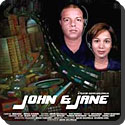
JOHN AND JANE
India, 2005, 83 minutes, Colour.
Directed by Ashim Ahluwalia.
John and Jane is an interesting and very topical documentary at the beginning of the 21st century. It is about western companies and their recruiting people in India to do telephone-answering jobs, soliciting sales, especially in the United States. This is a job which has featured in quite a number of English and American films – but here, it is criticised but shown to be one of the hopes for Indians who speak English, Indians who have ambitions to move into the world of business.
The film focuses on a range of Indians, filling in the background of their lives, their attitudes towards their work, their attitudes towards the Americans. It also features some training classes where the Indians are made to be quite Americanised in their pronunciation, language, their attitudes towards the people with whom they talk on the phone.
The film also focuses on the phone calls themselves, the quite different responses made by the Americans who are contacted by these Indians.
The film takes us into India, a different India from the traditions, an India of technological development, of outsourcing of jobs from Europe and America to the subcontinent.
1.The impact of the film as documentary and fiction? A portrait of people? A portrait of India in the 21st century? The impact of the United States and its culture? The impact for Indian audiences, American audiences, other international audiences?
2.The digital handheld New York opening, Times Square and the atmosphere of the United States? The voice – and finding that it belonged to an instructor in Mumbai? The contrast between India and the United States? The attempt at making a kind of United States in the offices in Mumbai? In the minds of the agents at the call centres?
3.The digital camerawork, the sense of realism, the focus on the people, the interviews, the workplaces, the environment of the new buildings? The old city of Mumbai?
4.India and the call centres, the flourishing industry, the Indians and their night work, especially for their American clients? The look of the offices, steel and glass? Modern? The phone booths?
5.The training sessions, the Indians having to lose their accent, acquire American accents? The practice of reciting sentences? The focus on John and Jane – the average American clients? The reminder of American qualities: individualism, achievement and success, privacy, the pursuit of happiness? The repetition of these values as a kind of brainwashing for the Indian agents?
6.The effect of this kind of work in India, on the Indian economy, culture and consciousness? On global finance? On the US with the clients? The world Americanised?
7.The presentation of the Americanisation? The agents’ voices, the dance styles, Pentecostal religion for an employee who used to be from the Hindu tradition, the visit to the Mc Donald’s and the various takeaway meals, the acquisition of the toys, the Coca- Cola culture? Food, language? The comments that the agents no longer felt Indian but American?
8.Glenn and his mother, waking him up, his going to work, seeing him at work, his friend, driving in the car, sitting looking over the slums? Sidney, his home life, his mother? Osmond and the dance routines, the instruction? Nikki and inheriting the guesthouse, her religious background, her sincere religious motivations of trying to do good for people? Nicholas, American mentality, seeing his wife, the preparation for the marriage, the different shifts, their meeting for twenty minutes, in the takeaway food? The toys? His wandering the environment, his absorbing American culture? Naomi, changing her Indian name, asserting that she was a natural blonde, looking for the ideal husband, absolutely Americanised?
9.The American voices on the phone, the contrast with American attitudes and Indian attitudes? The courtesy of the sales agents, their going through their routines, pressurising clients, in a gentle way, the negative views, the people hanging up, the people accepting? Their accepting this way of life?
10.What did the film say about India and its traditions, the present, an Indian future involved in the rapid economic growth, globalisation and American influence?